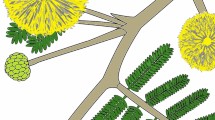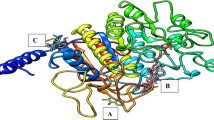Abstract
Croton cajucara Benth. (‘sacaca’) is a tree of the Euphorbiaceae family, native to the Amazon region in northern Brazil, where it is widely used in the popular treatment of various diseases. Its active principle, the terpenoid trans-dehydrocrotonin, has been credited with a variety of medical properties, including antiulcer, antiinflammatory, antitumor, antimutagenic and hypoglycemic activity. In this investigation, possible mutagenic and antimutagenic effects were evaluated in treatments using methanol extract of this plant on Swiss Albino mice by examining their peripheral blood cells for micronuclei. In these tests, the material obtained by methanol extraction of C. cajucara tree bark was administered to the mice by gavage. None of the doses evaluated in this study presented mutagenicity. Analysis of the results obtained from studies evaluating antimutagenicity revealed protection against the chemotherapeutic agent cyclophosphamide for the two highest doses used.
Similar content being viewed by others
Abbreviations
- b.w.:
-
body weight
- CP:
-
cyclophosphamide
- DCTN:
-
trans-dehydrocrotonin
- DMSO:
-
dimethyl sulfoxide
- ME:
-
methanol extract
- MNRET:
-
micronucleated reticulocyte
References
Agner A.R., Maciel M.A.M., Pinto A.C. & Cólus I.M.S. 2001. Antigenotoxicity of trans-dehydrocrotonin, a clerodane diterpene from Croton cajucara. Planta Med. 67: 815–819.
Agner A.R., Maciel M.A.M., Pinto A.C., Pamplona S.G.R.S. & Cólus I.M.S. 1999. Investigation of genotoxic activity of transdehydrocrotonin, a clerodane diterpene from Croton cajucara. Teratog. Carcinog. Mutagen. 19:377–384.
Ames B.N. 1983. Dietary carcinogens and anticarcinogens. Science 221: 256–1264.
Barcelos G.R.M, Shimabukuro F., Mori M.P., Maciel M.A.M. & Cólus I.M.S. 2007. Evaluation of mutagenicity and antimutagenicity of cashew stem bark methanolic extract in vitro. J. Ethnopharmacol. 114: 268–273.
Bighetti E.J., Hirima-Lima C.A., Gracioso J S. & Brito A.R. 1999. Anti-inflammatory and antinociceptive effects in rodents of the essential oil of Croton cajucara Benth. J. Pharm. Pharmacol. 51: 1447–1453.
Brito A.R., Rodriguez J.A., Hiruma-Lima C.A., Haun M. & Nunes D.S. 1998. Antiulcerogenic activity of transdehydrocrotonin from Croton cajucara. Planta Med. 64: 126–129.
Bruni R., Rossi D., Muzzoli M., Romagnoli C., Paganetto G., Besco E., Choquecillo F., Peralta K., Lora W.S. & Sacchetti G. 2006. Antimutagenic, antioxidant and antimicrobial properties of Maytenus krukovii bark. Fitoterapia 77: 538–545.
Cariño-Cortés R., Hernández-Ceruelos A., Torres-Valencia J.M., González-Avila M., Arriaga-Alba M., & Madrigal-Bujaidar E. 2007. Antimutagenicity of Stevia pilosa and Stevia eupatoria evaluated with the Ames test. Toxicol. In Vitro 21: 691–697.
Carvalho J.C., Silva M.F., Maciel M.A., Pinto A.C., Nunes D.S., Lima R.M. & Sarti S.J. 1996. Investigation of antiinflammatory and antinociceptive activities of trans-dehydrocrotonin, a 19-nor-clerodane diterpene from Croton cajucara. Part 1. Planta Med. 62: 402–404.
Craveiro A.A., Rodrigues A.S., Andrade C.H.S., Mattos F.J.A., Alencar J.W. & Machado M.I.L. 1981. Volatile constituents of Brazilian Euphorbiaceae — genus Croton. J. Nat. Prod. 44: 602–608.
De Flora S. 1998. Mechanisms of inhibitors of mutagenesis and carcinogenesis. Mutat. Res. 402: 151–158.
Ducke A. 1959. Estudos botânicos no Ceará. Anais da Academia Brasileira de Ciencias 31: 211–208.
Farias R.A., Rao V.S., Viana G.S., Silveira E.R., Maciel M.A. & Pinto A.C. 1997. Hypoglycemic effect of trans-dehydrocrotonin, a nor-clerodane diterpene from Croton cajucara. Planta Med. 63: 558–560.
Grynberg N.F., Echevarria A., Lima, J.E., Pamplona S.S.R., Pinto A.C. & Maciel M.A.M. 1999. Anti-tumor activity of two 19-nor-clerodane diterpenes, trans-dehydrocrotonin and trans-crotonin, from Croton cajucara. Planta Med.
Hayashi M., Morita, T., Kodama Y., Sofuni T. & Ishidate-Jr M. 1990. The micronucleus assay with mouse peripheral blood reticulocytes using acridine orange-coated slides. Mutat. Res. 245: 245–249.
Hecker E. & Schmidt R. 1974. Phorbolesters — the irritants and cocarcinogens of Croton tiglium L. Fortschr. Chem. Org. Naturst. 31: 377–467.
Hiruma-Lima C.A., Gracioso J.S., Rodríguez J.A., Haun M., Nunes D.S. & Brito A.R.M.S. 2000. Gastroprotective effect of essential oil from Croton cajucara Benth. (Euphorbiaceae). J. Ethnopharmacol. 69: 229–234.
Kritchevsky D. 1983. Fiber, steroids, and cancer. Cancer Res. 43: 2491–2495.
Kusamran W.R., Tepsuwan A. & Kupradinun P. 1998. Antimutagenic and anticarcinogenic of some Thai vegetables. Mutat. Res. 402: 247–258.
Maciel M.A.M., Pinto A.C., Arruda A.C., Pamplona S.G.S.R., Vanderlinde F.A., Lapa A.J., Cólus I.M.S., Echevarria A., Grynberg N.F., Farias R.A.F., Luna-Costa A.M. & Rao V.S.N. 2000. Ethnopharmacology, Phytochemistry and Pharmacology: a successful combination in the study of Croton cajucara. J. Ethnopharmacol. 70: 41–55.
Maciel M.A.M., Pinto A.C., Brabo S.N. & Da Silva M.N. 1998. Terpenoids from Croton cajucara. Phytochemistry 49: 823–828.
Maciel M.A.M., Pinto A.C., Veiga-Jr V.F., Martins J.R., Grynberg N.F., Echevarria A., Lapa A.J. & Vanderlinde F.A. 2002. Croton cajucara as an alternative to traditional medicine in a modern health system. Recent Progr. Med. Plants 8: 502–517.
Odek-Ogunde M. & Rajab M.S. 1994, Antihypertensive effect of the clerodane diterpene ajugarin I on experimentally hypertensive rats. J. East Afr. Med. 71: 587–590.
Olfert E.D., Cross B.M. & McWilliam A.A. 1993. The guide to the care and use of experimental animals, vol. 1. Canadian Council on Animal Care. http://www.ccac.ca/en/CCAC_Programs/Guidelines_Policies/GUIDES/ENGLISH/to c_v1.htm (accessed 14/03/2004).
Poersch A., Santos F.V., Maciel M.A.M., Câmara J.K.P., Dantas T.N.C. & Cólus I.M.S. 2007. Protective effect of DCTN (trans-dehydrocrotonin) against induction of micronuclei and apoptosis by different mutagenic agents in vitro. Mutat. Res. 629: 14–23.
Preston R.J., San Sebastián J.R. & McFee A. F. 1987. The in vitro human lymphocyte assay for assessing the clastogenicity of chemical agents. Mutat. Res. 189: 175–183.
Rosin M.P. 1992. The use of the micronucleus test on exfoliated cells to identify anti-clastogenic in humans: a biological marker for the efficacy of chemopreventive agents. Mutat. Res. 267: 265–276.
Santos F.V., Cólus I. M. S., Silva M.A., Vilegas W. & Varanda E.A. 2006a. Assessment of DNA damage by extracts and fractions of Strychnos pseudoquina, a Brazilian medicinal plant with antiulcerogenic activity. Food Chem. Toxicol. 44: 1585–1589.
Santos F.V., Mesquita S.F.P., Faria M.J.S.S., Poersh A., Maciel M.A.A., Pinto A.C., Morimoto H.K. & Cólus I.M.S. 2006b. Absence of mutagenicity in somatic and germ cells of mice submitted to subchronic treatment with an extract of Croton cajucara Benth. (Euphorbiaceae). Genet. Mol. Biol. 29: 159–165.
Vodicka P., Koskinen M., Vodicková, L., Stetina R., Smerák P., Bárta I. & Hemminki K. 2001. DNA adducts, strand breaks and micronuclei in mice exposed to styrene by inhalation. Chem. Biol. Interact. 137: 213–227.
Weber J. & Hecker E. 1978. Cocarcinogens of the diterpene ester type from Croton flavens L. and esophageal cancer in Curacao. Experientia 34: 679–682.
Author information
Authors and Affiliations
Corresponding author
Rights and permissions
About this article
Cite this article
dos Santos, F.V., da Silva Vieira dos Santos, V.J., Farias, M.J. et al. Mutagenicity and antimutagenicity of Croton cajucara . Biologia 63, 327–331 (2008). https://doi.org/10.2478/s11756-008-0064-5
Received:
Accepted:
Published:
Issue Date:
DOI: https://doi.org/10.2478/s11756-008-0064-5




